Neutral Color Palettes: How To Master
A Neutral Color Scheme And Neutral Paint Colors
Neutral color palettes are versatile, chic and simple.
But to understand neutral color combinations - and create neutral color schemes that work - you may need to tweak the way you look at your home.
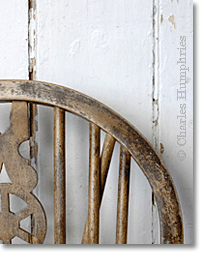
Purely neutral color palettes are made up of nothing but white, grays, and black.
If you relax this rule a little, neutral color schemes can also include browns, as well as mixtures of all of the above, including cream and beige.
You won't find neutral wall color on the color wheel, but most neutral paint colors are not entirely 'neutral' either - they carry a hint of color. They go beautifully with more saturated, "real" colors in an accented neutral color scheme.
This page is rather long, so if you're in a rush, here's your ...
... Executive Summary:
1. Look at your room as if it were a black-and-white photograph.
2. Make sure the dark and light values are well balanced.
3. Most neutrals carry a hint of color, so check all neutral paint colors and fabrics under different light sources to make sure they really form harmonious neutral color combinations.
4. Make your neutral color palettes interesting by varying textures, patterns, materials and finishes. Think of texture as light-and-shade patterns.
5. Beware of the effects of too much white and too much black.
6. Use neutral colors as a 'base' for your decorating, and add subtle color for variety, warmth, and interest.
There, that was your summary. For the full version, please read on!
The Big Picture: See Your Room as a Photograph
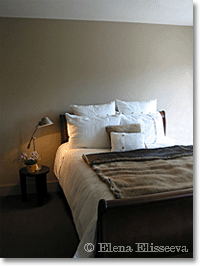
A black-and-white photograph is a neutral color palette; and with no colors to distract you, you can focus entirely on the play of light and shadow in the room.
So try pretending that your room is a photo, by squeezing your eyes half shut.
That blurs your vision and helps you see the darker and lighter areas as blocks of, well, dark and light. This way, you don't notice clutter so much (if indeed you have any :-) - anyway, you see the big picture in more or less neutral color.
Alternatively, just get a camera out and actually take black-and-white photos of the room during the decorating process.
Then ask yourself:
- What parts of the room is the eye drawn to? And is this where I want the attention to go?
The usual suspects are
- Areas that are busy with light and shade (or pattern) and
- Areas of stark contrast - 'chunks' of very dark and very light color values are not always easy on the eye.
You may find that a part of the room is just too dark, or that there is an area with too much going on.
If you want to brighten areas up, or bridge the gap between very dark and very light areas in neutral color palettes, textiles and paints are your best friends.
You can always
- paint a wall or two in neutral paint colors,
- (slip)cover a sofa,
- add a carpet or large area rug in a lighter/darker shade (small area rugs can add to visual clutter),
- change throws, cushions, or curtains.
Now, let's take a closer look at the colors.
Neutral Color Palettes Are Not All Neutral
A 'neutral color wheel' doesn't exist, but on closer inspection you will find a lot going on between neutrals and the color wheel. Of course, if you mix pure titanium white with pure black you will get various shades of seriously neutral gray. But these shades are hard to find in the 'real world'.
Most white fabrics in the shops have a slight tint - of blue, pink, yellow or cream. This is easy to see when you hold all the whites next to each other.
And the grays - don't get me started. Gray is a wonderful color, and extremely versatile, but there are more bluish, greenish and yellowish hues of gray than you can shake a paintbrush at.
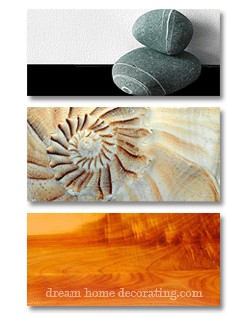
This is true for black as well. It comes in green, blue and brown hues. Particularly when you buy your decorating fabric it's important to look at it in different lights (natural and artificial), and see it together with the other colors you want to use in a neutral color palette.
Brown has people wondering about its membership in the neutral color clan. Is brown a neutral color at all? No and yes. It's usually included in neutral color palettes, sometimes as a 'near-neutral' color, but you can get browns that are quite biased - deeply red or orange or greenish/gray.
Brown can play an important role in neutral color palettes because it comes in so many subtle and complex hues. It can pull the whole scheme together and give it depth. The patina of worn leather, the vividness of beautifully textured wood can add as much life to neutral color palettes as patterned fabrics do.
And speaking of patterns - they don't have to be printed or woven
patterns. Shadows create patterns as well. So you could use textured
materials to add interest to simple neutral color palettes.
Texture Adds Sensory Richness
Most surfaces are good candidates for adding texture:
- Textured sisal or wool carpets and rugs can 'warm up' the floor.
- Accessories made of woven natural fibres or pleated leather add soft lines and a tactile element.
- Slightly three-dimensional finishes on walls or ceilings, for example textured wallpapers and/or paints, can provide further interest.
Apart from these options, textured fabrics are a fairly inexpensive and interesting way to add sensory richness to a combination of neutral colors. For an elegant look and feel, mix
- silk velvet,
- raw and doupion silks,
- devore,
- wovens with raised patterns, and
- exquisite embroidery.
If you prefer a relaxed living space, create neutral color palettes with
- fine and coarse linens,
- chunky knits,
- leather,
- suede,
- corduroy, and
-
velvets.
Putting A Neutral Color Scheme Together
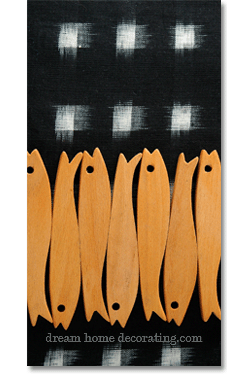
Some people claim that any neutral colors work together. I don't think that's true. Here are a few points to be aware of when you create a neutral color scheme in your home.
- A neutral color combination can look boring if there is not enough contrast. You might want to use some really crisp, bright accent color to keep the look fresh, for example white gloss paint on window frames and baseboard, milk-white walls, or curtains and cushions in a light neutral color, or a crisp light pattern on a darker ground.
- Too much beige, particularly if it's a yellow-hued beige, can make a room look tired and a bit depressing. To liven it up, add lighter and/or darker neutrals.
- Hard, shiny surfaces and dark colors sometimes create an austere look and feel. Neutral color palettes that consist mostly of black and white can have the same effect. Adding some natural wood (and maybe even subtle touches of color), will warm a room up and make neutral color combinations more welcoming.
- If the room does not have good natural light, a neutral color combination might look a bit 'bloodless' - unless you use warm brown and beige hues with a lot of red and orange in them. Even then, lighting is a real issue here. You need the shadows that bring a textured surface to life, so you want good light sources (at an angle, not just from above).
- When mixing cool and warm neutrals, use white with care: Beware of the blue tints of chemically bleached fabrics - they will throw neutral color palettes off and give them a 'fake' look.
-
Summer sunshine on large amounts of brilliant white can create quite a glare. So in a very bright
room, unless you want to keep your sunglasses ready at all times, you could opt for an interior
design scheme of off-whites combined with a few darker neutrals.
Almost-Neutral Color Palettes
Even if you're one of the purist crowd, it can be quite difficult to keep color out of the black-and-white picture that is your home. Some blue sky outside your window is practically enough to ruin your efforts!
Adding 'real' color to neutral color palettes is a bit like adding spice to a meal. You don't need much, but what you do add gives your composition a distinct flavor. So how about an "accented" neutral color scheme?
Here are some of the points to consider when you inject color into a combination of neutrals:
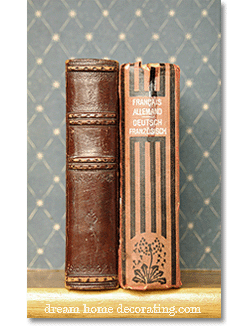
- Neutrals go with most colors, but success is easier if you stick to one color family. (For more information about color families, have a look at the color wheel. Also, make sure the colors you add don't look 'synthetic' or flat. It helps if they are related to the neutrals, so as if they contained a bit of white, beige, grey, or brown.
- 'All-white' color schemes often look great with just a hint of color, for example a mix of pale grey/blue/green. Colors look their most vibrant against a background of white. Even a little color will have a great impact.
- A neutral color palette makes a great unifying element in a home. Every room can have its own selection of added color, but the neutrals anchor the overall look.
- If you move house a lot, it's good to have some key pieces of furniture in co-ordinated neutral colors. They're easy to regroup in a new home, and you can quickly create a 'look' that fits the new environment.
- Neutral color palettes can easily be 'updated' on a budget. Add a few new textiles, art,
and wall paint - and you have a new room.
If you're looking for more information about finding great color schemes for your home, do check out some of the following links:
- Neutral Color Schemes - The
Book:
Learn more about using neutral color palettes in your home! Understand what makes a neutral color scheme look great, and what happens when you inject 'real' color into neutral color palettes. It's FREE!! - Spruce up your neutral color combinations with more saturate room color schemes.
- How do you choose decorating colors, including neutral paint colors? Click here for a (foolproof) step-by-step process!
- The perfect complement for neutral wall color - great color combinations.
- Neutral paint colors for the bedroom? - Color psychology will tell you why - or why not - that's a good idea.
- Click on the individual colors to read up on their psychological effects: white, gray, black, brown, yellow, orange, red, pink, purple, blue, green.



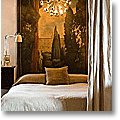
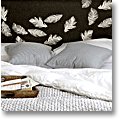
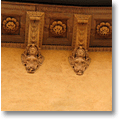
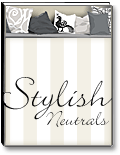
New! Comments
Have your say about what you just read! Leave me a comment in the box below.